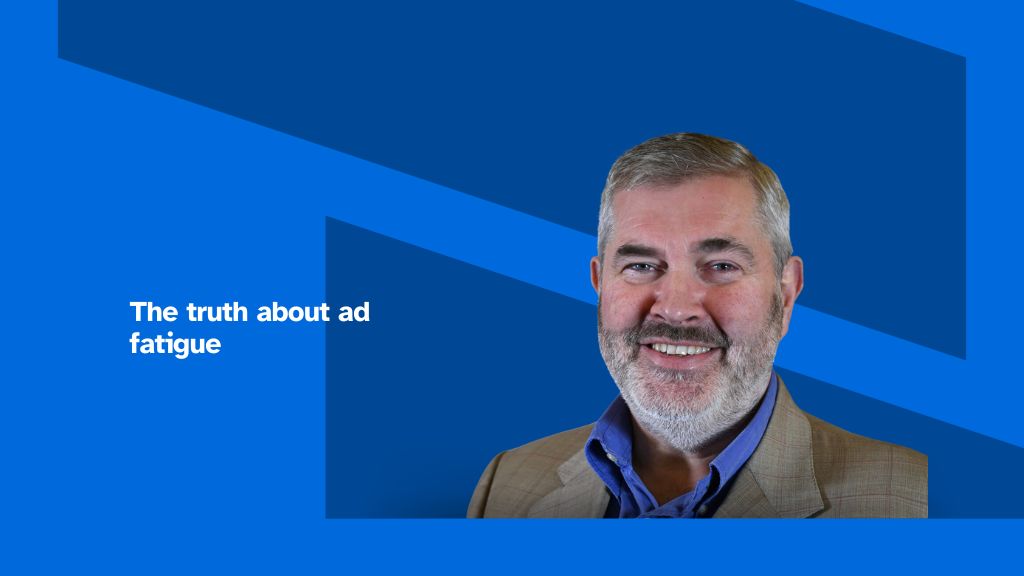By Roger Jackson, CEO, SenseCheck
In the ever-evolving marketing landscape, the term “ad fatigue” has become a common refrain in marketing discussions.
This concept suggests consumers are growing increasingly weary of advertisements in general, leading to diminishing returns on marketing investments. It has marketers on edge, fearing that their carefully crafted campaigns might fall flat. They then feel the need to keep changing their creative ideas to keep things “fresh”.
But, is ad fatigue truly the insurmountable barrier it’s often portrayed to be, or is there more nuance to the story?
Separating myth from reality
Data from reputable sources like Kantar, System1, and Analytic Partners suggest the common wisdom about ad wear-out might be more myth than reality. It’s not the case that seeing one particular ad more than a certain number of times necessarily stops it “working”.
Analytic Partners, for instance, conducted an extensive analysis of over 50,000 ads in 2020. Their findings were striking: only 14 campaigns had run their full course and exhibited signs of wear-out when they were replaced. The remaining 51,232 ads were pulled despite not showing any signs of audience fatigue.
This discrepancy highlights a critical insight: wear-out rarely happens among target consumers. Instead, it appears marketers themselves may be the ones experiencing fatigue, growing impatient with their existing tactics and eager for fresh creative content.
This phenomenon underscores the importance of distinguishing between the perceived wear-out from the marketer’s perspective and the actual impact on the audience. The problem of wear-out is, in essence, a challenge for marketers, not the market.
Consumer preferences and advertising fatigue
Contrary to the narrative of widespread ad fatigue, recent statistics indicate consumers, especially younger generations, still value well-crafted ads.
For example, a notable 81 per cent of Gen Zers and 57 per cent of Millennials report enjoying personalised ads tailored to their interests and preferences. This enthusiasm for personalised ads suggests the issue isn’t with the volume of ads, but with their relevance and delivery.
What consumers do find objectionable are disruptive ads that interrupt their online experience. A significant portion of the audience, around 53 per cent, shows a preference for native advertising over traditional or banner ads.
Native ads, which blend seamlessly with the content and context of the platform, are less intrusive and more engaging. This preference indicates that, while consumers are open to advertising, they have a clear preference for ads that respect their user experience and provide value without being disruptive.
The reality of marketing exposure
A critical oversight among marketers is the assumption that consumers are as immersed in their ads as they are. In reality, while marketers see their campaigns daily, these ads are merely a small part of consumers’ broader media consumption. Most ads go unnoticed most of the time, simply because consumers don’t pay them the same level of attention the marketing team does. The reality is they are busy doing other things.
Historically, the concept of ad wear-out due to repetition was widely accepted, particularly in the context of TV advertising. However, substantial evidence to support this claim is lacking. In fact, marketing scientists often observe the opposite: increased ad frequency typically leads to better results. The challenge lies in striking the right balance between frequency and creative variation to maintain engagement without overwhelming the audience.
Understanding the Reticular Activating System [RAS]
The Reticular Activating System [RAS] in our brains plays a crucial role in determining what we notice amid the millions of stimuli we encounter each day.
This system filters information based on what we already deem important, meaning marketers are far more attuned to their ads than the average consumer. The RAS highlights familiar and relevant stimuli, helping individuals focus on what matters to them personally.
For marketers, this means breaking into a customer’s consciousness is inherently challenging. However, repetition can aid in this process by reinforcing brand messages and increasing the likelihood of being noticed.
Understanding the function of the RAS helps marketers appreciate why repeated exposure is necessary and beneficial for embedding brand messages in consumers’ minds.
The power of familiarity in advertising
One of the fundamental principles of effective advertising is leveraging the power of familiarity.
Familiar ads don’t wear out quickly because they provide a sense of comfort and reassurance. Familiarity breeds trust and recognition – essential components in consumer decision-making. People tend to favour what they know, and repeated exposure to an ad can strengthen this familiarity.
While it’s true that overly repetitive ads can become annoying if the ads are themselves annoying, in reality most ads fall into a neutral “ho hum” category that poses little risk of alienation. Marketing is essentially a battle for mind space, and achieving high recall and recognition is a significant win.
Even ads that some might find irritating can be effective if they ensure the brand is remembered and communicate the benefit effectively.
The goal of marketing: being top of mind
The ultimate aim of marketing is to capture attention and occupy a permanent spot in the consumer’s mind.
Successful campaigns ensure that, when consumers think about a specific category, their brand is the first that comes to mind. This top-of-mind awareness is crucial for driving purchase decisions, as consumers often choose the most familiar option when faced with multiple choices.
In a complex and crowded marketplace, simplicity and familiarity can be powerful allies. Consumers typically opt for the path of least resistance, which often means choosing brands they recognise and trust. This behaviour underscores the importance of persistent and consistent advertising to maintain visibility and relevance in consumers’ minds.
Wear-out isn’t the real problem
Given these insights, it’s clear that wear-out isn’t the primary issue facing marketers. Instead, the challenge lies in overcoming personal fatigue and maintaining confidence in proven strategies.
Marketers may tire of their ads before the audience does, driven by the desire for novelty or the need to make a personal mark. This tendency can lead to unnecessary changes and disruptions in successful campaigns.
To counteract this, marketers should rely on metrics and performance data to guide their decisions. Celebrating the success of “boring” but effective ads is essential for maintaining consistency and achieving long-term goals.
In the end, the focus should be on what works, not on changing strategies out of impatience or the desire for newness. Wear-out is more about the marketers’ perspective than the consumers’, and recognising this can lead to more effective and enduring advertising efforts.










